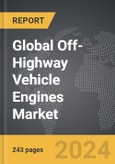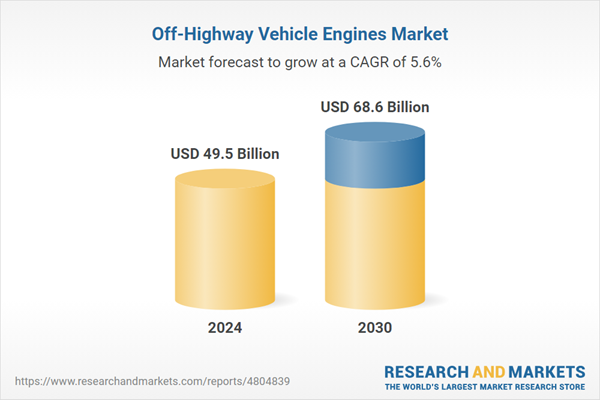Global Off-Highway Vehicle Engines Market - Key Trends and Drivers Summarized
How Are Off-Highway Vehicle Engines Revolutionizing Heavy-Duty Applications and Environmental Impact?
Off-highway vehicle engines are revolutionizing heavy-duty applications and environmental impact by providing powerful, efficient, and durable solutions for machinery used in industries such as construction, agriculture, mining, and forestry. These engines are specifically designed to handle the demanding conditions of off-highway environments, where reliability, torque, and fuel efficiency are paramount. Unlike on-road vehicles, off-highway vehicles (OHVs) operate in rugged terrains, often for extended periods, requiring engines that can deliver consistent performance under extreme loads and variable conditions. Modern off-highway vehicle engines incorporate advanced technologies that enhance fuel efficiency, reduce emissions, and improve overall engine longevity, making them crucial components in reducing the environmental footprint of heavy-duty operations. As industries increasingly focus on sustainability and cost-effectiveness, these engines are becoming central to the evolution of heavy machinery, enabling higher productivity while adhering to stricter environmental standards.What Innovations Are Enhancing the Functionality of Off-Highway Vehicle Engines?
Innovations in off-highway vehicle engines are enhancing their functionality through advancements in emissions control, fuel efficiency, and hybridization. One of the most significant developments is the integration of advanced emissions control technologies, such as selective catalytic reduction (SCR) and diesel particulate filters (DPFs). These technologies reduce harmful emissions like nitrogen oxides (NOx) and particulate matter, enabling off-highway vehicles to meet stringent global emissions standards, such as the U.S. EPA Tier 4 and the EU Stage V regulations. By incorporating these systems, manufacturers can produce engines that are not only compliant with current regulations but also future-proof against anticipated environmental policies.Fuel efficiency improvements are another key innovation, driven by the development of high-pressure common rail fuel injection systems, turbocharging, and engine downsizing. These technologies optimize the combustion process, allowing engines to deliver more power with less fuel, which is critical for reducing operational costs in industries where fuel consumption represents a significant portion of operating expenses. Turbocharging, for example, increases the engine's power output without requiring a larger engine displacement, thereby improving fuel efficiency and reducing emissions. Additionally, advanced engine management systems that use real-time data to adjust engine parameters are helping to maximize efficiency and performance in varying operational conditions.
The trend towards hybridization and electrification is also beginning to influence off-highway vehicle engines. Hybrid engines, which combine internal combustion engines with electric powertrains, offer the potential for significant fuel savings and emissions reductions. These systems can provide additional power for peak loads, improve fuel economy by using electric power for low-demand operations, and reduce noise levels, which is particularly beneficial in urban construction sites and sensitive environments. While fully electric off-highway vehicles are still in the early stages of development, hybrid systems represent a promising step towards reducing the environmental impact of heavy-duty machinery.
These innovations are making off-highway vehicle engines more efficient, powerful, and environmentally friendly, ensuring they meet the demands of modern industries while contributing to global sustainability efforts.
How Do Off-Highway Vehicle Engines Impact Industrial Operations and Environmental Sustainability?
Off-highway vehicle engines have a significant impact on industrial operations and environmental sustainability by driving productivity while reducing the environmental footprint of heavy machinery. In industrial operations, these engines are the backbone of machinery that performs essential tasks such as earthmoving, material handling, and excavation. The power and reliability of off-highway vehicle engines enable machines to operate effectively in harsh conditions, from construction sites to mining operations, ensuring that projects are completed on time and within budget. The durability of these engines, combined with their ability to operate continuously under heavy loads, reduces downtime and maintenance costs, which are critical factors in maintaining operational efficiency and profitability in industries where equipment failure can lead to significant financial losses.From an environmental sustainability perspective, the advancements in off-highway vehicle engines are critical to reducing the carbon footprint of heavy industries. The integration of emissions control technologies and the push towards greater fuel efficiency mean that modern engines produce fewer greenhouse gases and other pollutants compared to their predecessors. This reduction in emissions is crucial in industries such as construction and mining, which have historically been significant contributors to air pollution and environmental degradation. By adopting engines that meet or exceed current emissions standards, companies can mitigate their impact on the environment while also preparing for more stringent regulations in the future.
Moreover, the trend towards hybridization and the potential for electrification in off-highway vehicles offer additional opportunities for reducing environmental impact. Hybrid engines can lower fuel consumption and emissions during operations, particularly in start-stop conditions where traditional engines are less efficient. The adoption of these technologies not only supports environmental goals but also enhances the public perception of industries traditionally seen as polluters, aligning them more closely with global sustainability initiatives.
By improving both operational efficiency and environmental sustainability, off-highway vehicle engines are essential components in the evolution of heavy-duty machinery, helping industries to meet the dual challenges of productivity and environmental responsibility.
What Trends Are Driving Growth in the Off-Highway Vehicle Engines Market?
Several trends are driving growth in the off-highway vehicle engines market, including increasing regulatory pressures, technological advancements, and the demand for greater efficiency and sustainability in heavy industries. One of the primary drivers is the tightening of emissions regulations across the globe, with governments imposing stricter standards on pollutants such as nitrogen oxides (NOx) and particulate matter. These regulations are pushing manufacturers to develop cleaner, more efficient engines that can comply with new standards, driving innovation and investment in emissions control technologies.Technological advancements are another significant trend influencing the market. The development of more sophisticated engine management systems, improved fuel injection technologies, and the integration of turbocharging are enhancing the performance and efficiency of off-highway vehicle engines. These innovations allow for greater power output and fuel savings, which are critical in industries where operational costs are tightly controlled. Additionally, the ongoing research and development in hybrid and electric powertrains for off-highway vehicles are setting the stage for future growth, as industries look to reduce their reliance on fossil fuels and minimize their environmental impact.
The demand for greater efficiency and sustainability in heavy industries is also driving the adoption of advanced off-highway vehicle engines. As companies strive to improve their operational efficiency and reduce their carbon footprint, they are increasingly turning to engines that offer better fuel economy, lower emissions, and enhanced durability. This demand is particularly strong in sectors like construction, mining, and agriculture, where the cost of fuel and compliance with environmental regulations are major concerns.
Furthermore, the rise of digitalization and smart technologies in the industrial sector is influencing the off-highway vehicle engines market. The integration of telematics, IoT, and predictive maintenance technologies with engine systems is allowing for more precise monitoring and management of engine performance. This not only improves efficiency and reduces downtime but also provides valuable data that can be used to optimize operations and extend the lifespan of equipment.
These trends highlight the growing importance of off-highway vehicle engines in the global economy, as they continue to evolve to meet the challenges of modern industrial operations while supporting environmental sustainability. As the market expands, innovations in engine technology will play a crucial role in shaping the future of heavy-duty machinery and its impact on the world.
Report Scope
The report analyzes the Off-Highway Vehicle Engines market, presented in terms of market value (USD). The analysis covers the key segments and geographic regions outlined below.- Segments: Fuel (Diesel, Gasoline, Other Fuels).
- Geographic Regions/Countries: World; United States; Canada; Japan; China; Europe (France; Germany; Italy; United Kingdom; Spain; Russia; and Rest of Europe); Asia-Pacific (Australia; India; South Korea; and Rest of Asia-Pacific); Latin America (Argentina; Brazil; Mexico; and Rest of Latin America); Middle East (Iran; Israel; Saudi Arabia; United Arab Emirates; and Rest of Middle East); and Africa.
Key Insights:
- Market Growth: Understand the significant growth trajectory of the Diesel Fuel segment, which is expected to reach US$48 Billion by 2030 with a CAGR of 5.9%. The Gasoline Fuel segment is also set to grow at 5.1% CAGR over the analysis period.
- Regional Analysis: Gain insights into the U.S. market, valued at $12.9 Billion in 2024, and China, forecasted to grow at an impressive 8.3% CAGR to reach $15.5 Billion by 2030. Discover growth trends in other key regions, including Japan, Canada, Germany, and the Asia-Pacific.
Why You Should Buy This Report:
- Detailed Market Analysis: Access a thorough analysis of the Global Off-Highway Vehicle Engines Market, covering all major geographic regions and market segments.
- Competitive Insights: Get an overview of the competitive landscape, including the market presence of major players across different geographies.
- Future Trends and Drivers: Understand the key trends and drivers shaping the future of the Global Off-Highway Vehicle Engines Market.
- Actionable Insights: Benefit from actionable insights that can help you identify new revenue opportunities and make strategic business decisions.
Key Questions Answered:
- How is the Global Off-Highway Vehicle Engines Market expected to evolve by 2030?
- What are the main drivers and restraints affecting the market?
- Which market segments will grow the most over the forecast period?
- How will market shares for different regions and segments change by 2030?
- Who are the leading players in the market, and what are their prospects?
Report Features:
- Comprehensive Market Data: Independent analysis of annual sales and market forecasts in US$ Million from 2024 to 2030.
- In-Depth Regional Analysis: Detailed insights into key markets, including the U.S., China, Japan, Canada, Europe, Asia-Pacific, Latin America, Middle East, and Africa.
- Company Profiles: Coverage of players such as Agrale SA, Cummins India Ltd., Cummins, Inc., Dahmer Powertrain, Inc., Dayco IP Holdings, LLC and more.
- Complimentary Updates: Receive free report updates for one year to keep you informed of the latest market developments.
Some of the 44 companies featured in this Off-Highway Vehicle Engines market report include:
- Agrale SA
- Cummins India Ltd.
- Cummins, Inc.
- Dahmer Powertrain, Inc.
- Dayco IP Holdings, LLC
- Deere & Company
- Deutz AG
- Farmland Tractor Supply, Inc.
- Greenkraft, Inc.
- Kubota Agricultural Machinery India Pvt. Ltd.
This edition integrates the latest global trade and economic shifts into comprehensive market analysis. Key updates include:
- Tariff and Trade Impact: Insights into global tariff negotiations across 180+ countries, with analysis of supply chain turbulence, sourcing disruptions, and geographic realignment. Special focus on 2025 as a pivotal year for trade tensions, including updated perspectives on the Trump-era tariffs.
- Adjusted Forecasts and Analytics: Revised global and regional market forecasts through 2030, incorporating tariff effects, economic uncertainty, and structural changes in globalization. Includes historical analysis from 2015 to 2023.
- Strategic Market Dynamics: Evaluation of revised market prospects, regional outlooks, and key economic indicators such as population and urbanization trends.
- Innovation & Technology Trends: Latest developments in product and process innovation, emerging technologies, and key industry drivers shaping the competitive landscape.
- Competitive Intelligence: Updated global market share estimates for 2025, competitive positioning of major players (Strong/Active/Niche/Trivial), and refined focus on leading global brands and core players.
- Expert Insight & Commentary: Strategic analysis from economists, trade experts, and domain specialists to contextualize market shifts and identify emerging opportunities.
Table of Contents
Companies Mentioned (Partial List)
A selection of companies mentioned in this report includes, but is not limited to:
- Agrale SA
- Cummins India Ltd.
- Cummins, Inc.
- Dahmer Powertrain, Inc.
- Dayco IP Holdings, LLC
- Deere & Company
- Deutz AG
- Farmland Tractor Supply, Inc.
- Greenkraft, Inc.
- Kubota Agricultural Machinery India Pvt. Ltd.
Table Information
| Report Attribute | Details |
|---|---|
| No. of Pages | 243 |
| Published | December 2025 |
| Forecast Period | 2024 - 2030 |
| Estimated Market Value ( USD | $ 49.5 Billion |
| Forecasted Market Value ( USD | $ 68.6 Billion |
| Compound Annual Growth Rate | 5.6% |
| Regions Covered | Global |









